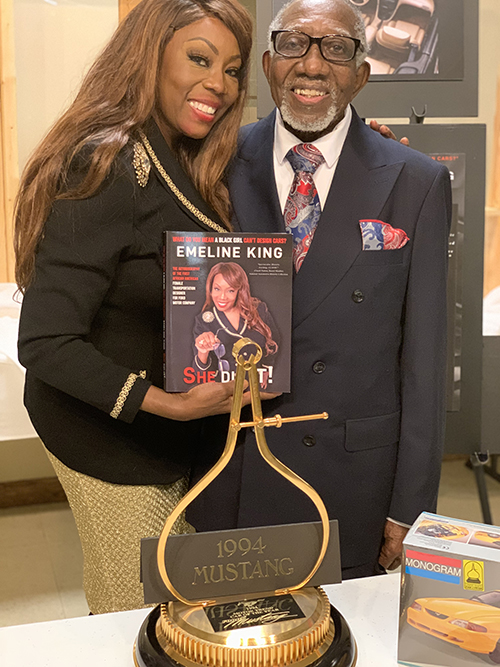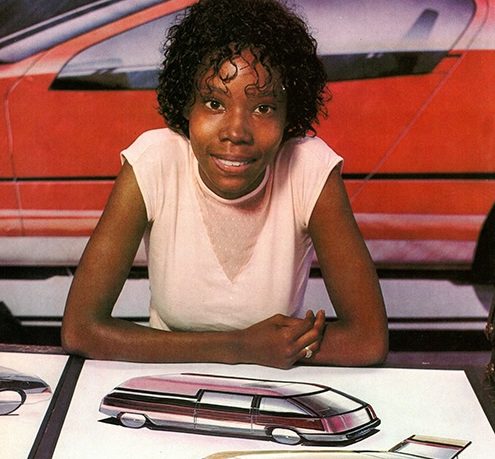By Mekhi Abbott
Special to the AFRO
mabbott@afro.com
Emeline King displays her designs. Photo courtesy of Wayne State University
Emeline King is responsible for designing the 1994 SN95 Ford Mustang. In doing so, she became the first Black women transportation designer for Ford Motor Company.
King’s father was a fabrication specialist at Ford and King had her eyes and heart set on exactly what she wanted to do from a young age.
“It all started at the age of 11,” said King. “ introduced me to his coworkers and I noticed a set of blue doors. When I tried to open the door my dad told me I couldn’t go behind them because I wasn’t an employee and behind those doors were men and they were called ‘transportation designers. They designed every car that you saw going up the road.’”
 Shown here, Emeline King with her father, Rev. Earnest O. King Sr., and a copy of her book, “What Do You Mean A Black Girl Can’t Design Cars?” Photo courtesy of Wayne State University
Shown here, Emeline King with her father, Rev. Earnest O. King Sr., and a copy of her book, “What Do You Mean A Black Girl Can’t Design Cars?” Photo courtesy of Wayne State University
To keep her occupied, King’s father used to take her to a studio owned by the famous Black sculptor, Oscar Graves. Graves taught King how to make clay car models and King recalls Graves telling her she could make a great artist or sculptor some day. That is something King kept with her.
“I was so intrigued in hearing that, I decided that I wanted to become a car designer and I wanted to work at Ford designing cars,” said King.
Although some of the men in her life spoke life into her dream of being a car designer one day, King also recalls times where others attempted to discourage her from achieving that goal.
“I was attending Keidan Elementary School and we would have ‘show and tell.’ I bought my car made out of clay and I would draw pictures of cars and such but it was my male teacher who told me that because I was a girl, I couldn’t design cars,” said King,who attended elementary school in Detroit. “He didn’t know my father was my big mentor. He introduced me to this world and I was being mentored from all angles.”
King knew she would be discouraged, but didn’t let it change her path. “I didn’t let that stop me from achieving my goals,” she said.
After completing her undergraduate studies in Transport Design at the Art Center College of Design in Pasadena, Cali. and obtaining a BFA in Industrial Design from Wayne State University, King made the decision that she only wanted to be hired at Ford Motor Company.
And her dream came true. King would eventually get hired and work there for 24 years, but even in that experience, she still felt pushback when trying to achieve some of her professional goals.
“From the time I was hired on Oct. 24, 1983 until I was let go in 2008, I was largely the only female car designer at the company. I was doing all this work but I was not getting promoted. I was watching Ford hire male designers and seeing them get promoted. They even started hiring female designers that were getting promoted before me,” said King.
After being overlooked on a lot of projects, King decided to go to management to request to be put on a “hot project.” Ford was in the process of redesigning the 1964 Mustang and King took this as an opportunity to finally be able to do what she had always dreamt of doing.
“I knew I had to come up with something different. So I said, ‘Okay, I’m gonna start thinking about females and how they design things and take into account things women would want in a car,’” said King.
Typically, male designers didn’t take into consideration things women would appreciate in the interior of muscle cars. King realized this and got to work.
“If I’m on this project, I will make sure it is designed with women in mind. So all the features were catered to a more broad audience. It was still going to stay a muscle car but it’s just going to have more of a soft touch,” said King.
King made sure she paid attention to detail. She made sure the interior was more elevated. She made sure the knobs, switches, door handles and instrument panels were smooth and rounded surfaces so women wouldn’t break their nails. She made the seats more comfortable. She made sure that women would be able to get in and out of the vehicle tearing or ruining their gowns or skirts. She even brightened up the colors and made sure the fabrics weren’t as rough and didn’t cause as much friction.
Her work did not go unnoticed. While employed at Ford and even after, King recalls being invited to speak to a lot of women’s groups and hearing a lot of warm receptions for her contributions to the ‘94 Ford Mustang.
King would go on to write an autobiography titled “What Do You Mean A Black Girl Can’t Design Cars?” She was also recognized at the Detroit Institute of Arts back in 2022 for her contributions to the ‘94 Ford Mustang in an exhibit highlighting Detroit’s history as the hub of American car and automotive design.
“As someone who loves classic cars, it’s cool to know that a Black woman designed the interior of one of my favorite models of cars. What’s really amazing is that although she was told by male teachers that a girl couldn’t design cars, or that she ‘would be better at being a housewife,’ she had great Black male mentors within the car industry that took the time to teach her and assisted in helping her grow into the amazing car designer that she became,” said Cierra Brown, a sophomore at the University of the Arts in Philadelphia. “She pushes the envelope by simply existing in a place that wasn’t ‘normal’ for women– let alone a Black woman!”



